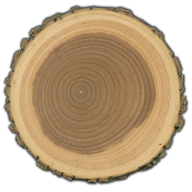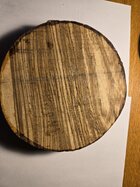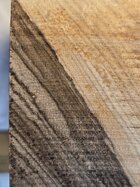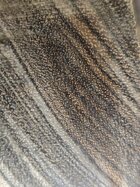-
December 2025 Turning Challenge: Single Tree! (click here for details) -
Congratulations to Bob Henrickson, People's Choice in the November 2025 Turning Challenge (click here for details) -
Congratulations to Guillaume Fontaine for "Old Tea Pot" being selected as Turning of the Week for December 15, 2025 (click here for details) -
Welcome new registering member. Your username must be your real First and Last name (for example: John Doe). "Screen names" and "handles" are not allowed and your registration will be deleted if you don't use your real name. Also, do not use all caps nor all lower case.
You are using an out of date browser. It may not display this or other websites correctly.
You should upgrade or use an alternative browser.
You should upgrade or use an alternative browser.
Wood id
- Thread starter Peter D'Attomo
- Start date
The folks that know how to ID wood prefer a shot of the end grain. If you want more than, "Looks like..____..to me", post another photo.
I suspect it's Olive Ash but would appreciate confirmation.
I do lot of wood id by looking at end grain under magnification. There are just too many species and variations within species to do a positive ID from the visual appearance in a photo of the side grain. Look at the incredible variation within some species on this site:
I don't have experience with Olive Ash.
You might read this article, especially section 7:
Wood Identification Guide | The Wood Database
Where did you get the wood? Knowing where it came from and where the tree grew helps a lot - locally grown? Bought from a wood dealer?
If unknown, there are simply too many species around the world that have similar appearance. For example, some Zebrano looks much like the piece you have.
Besides the end grain examination, other clues are density and smell. Having the wood in hand helps a lot.
Unfortunately, it is often easier to rule out a candidate species than to make a positive ID.
For more on wood ID I recommend the book "Identifying Wood" by R. Bruce Hoadley.
If you can't make a positive ID you might do what many do: write the name of what you think it might be on the back and never look back!
I once saw a bowl marked Cherry but the wood was definitely ring porous, even without a magnifier!
JKJ
If it could be an exotic wood I would lean towards Zebra Wood, but as others have said there are lots of possibilities
Tom Gall
TOTW Team
As @John K Jordan and @Kent Jaffrey mentioned .... looks like Zebrawood to me. When you cut it or turn it and it smells like you are visiting the zoo - it's Zebrawood.
I would guess it is the Zebra/Zebrano wood as well. Ash is fairly easy to identify, quite open grained and splits easily as in firewood. The "olive ash" is the brown heart wood in the older ash trees. If you bought that in a store, I would suspect Zebrano long before I would think olive ash.
robo hippy
robo hippy
The surface looks rough, as if sawn.
To get a smooth, clear surface, I use a single-edged razor blade and shave of a section of the end grain surface in the heartwood, enough that at least several rings, the pores, parenchma, tyloses, and possibly rays are visible. This is described a bit in the WoodDatabase article but better in the Hoadley book. The best place to examine is away from the pith and away from the sapwood. I typically cut a section about 1/2” x 1” any thickness, enough to hold by hand, then shave a clean section. I NEVER prepare the sample by sanding, regardless of how hard it is (it can fill the pores with sawdust). However, you may not want to cut into the blank so the clean patch can be somewhere near the edge.
You need enough magnification to compare to 10x end grain photos such as those in the Identification section on this page (for Zebra Wood)
 www.wood-database.com
www.wood-database.com
It would be nice to know the density. Weigh the blank then measure the size in all dimensions to get the volume. We can convert to compare to the densities listed in the databases for candidate woods. Is the wood green or dry?
Do you know if the tree was grown in England? If it came from a dealer, would they know more?
What does the wood smell like when you cut it?
To get a smooth, clear surface, I use a single-edged razor blade and shave of a section of the end grain surface in the heartwood, enough that at least several rings, the pores, parenchma, tyloses, and possibly rays are visible. This is described a bit in the WoodDatabase article but better in the Hoadley book. The best place to examine is away from the pith and away from the sapwood. I typically cut a section about 1/2” x 1” any thickness, enough to hold by hand, then shave a clean section. I NEVER prepare the sample by sanding, regardless of how hard it is (it can fill the pores with sawdust). However, you may not want to cut into the blank so the clean patch can be somewhere near the edge.
You need enough magnification to compare to 10x end grain photos such as those in the Identification section on this page (for Zebra Wood)
Zebrawood | The Wood Database (Hardwood)
It would be nice to know the density. Weigh the blank then measure the size in all dimensions to get the volume. We can convert to compare to the densities listed in the databases for candidate woods. Is the wood green or dry?
Do you know if the tree was grown in England? If it came from a dealer, would they know more?
What does the wood smell like when you cut it?
Last edited:
The wood came from Yandle & Sons. I assume it was harvested in Europe.
Very open grained, as in lots of pore holes. Zebra wood. I would take a hand plane to it for a clearer view.
robo hippy
robo hippy
I located a confirmed piece of Zebrawood and the grain matches. Thank you all, for your help.



